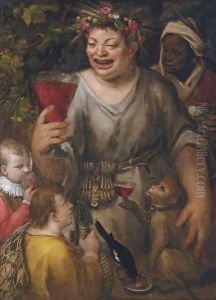Sebastiano Filippi II, Il Bastianino Paintings
Sebastiano Filippi, better known as Il Bastianino, was an Italian painter of the Renaissance period, active mainly in his hometown of Ferrara, Italy. Born in 1536, he was the son of Camillo Filippi, who was also a painter and the first to instruct him in the art of painting. His brother, Cesare Filippi, was likewise a painter, and together they continued the artistic legacy of their family. Il Bastianino's style was notably influenced by the Mannerist movement, which was characterized by artificiality, grace, and elegance, departing from the more naturalistic qualities of High Renaissance art.
Il Bastianino's work is distinguished by his use of elongated figures and a strong emphasis on chiaroscuro—the contrast between light and dark—to achieve a sense of depth and volume. His compositions often feature dramatic lighting and a skillful use of perspective. He was heavily influenced by the work of Michelangelo, whose iconic style can be seen in Bastianino's robust figures and complex poses.
Among his most important works is the large fresco 'The Last Judgment' in the Cathedral of Ferrara, which he completed over several years and finished in 1577. This grandiose work showcases his mastery of Mannerist techniques and his ability to handle large-scale compositions. His other significant works include 'The Martyrdom of St. Catherine' and the 'Adoration of the Magi'. Bastianino's paintings can be found in various churches and collections throughout Ferrara and the surrounding region.
Il Bastianino's career spanned the late Renaissance period, a time of great change in the arts, where the transition from the High Renaissance to Mannerism took place. His contributions to the art of this period are noted for their emotional intensity and complex iconography, reflecting the intellectual and spiritual concerns of the time.
Sebastiano Filippi, Il Bastianino, died in 1602. His legacy is preserved in the form of his paintings, which continue to be studied and admired for their unique blend of Renaissance ideals and Mannerist innovation.
